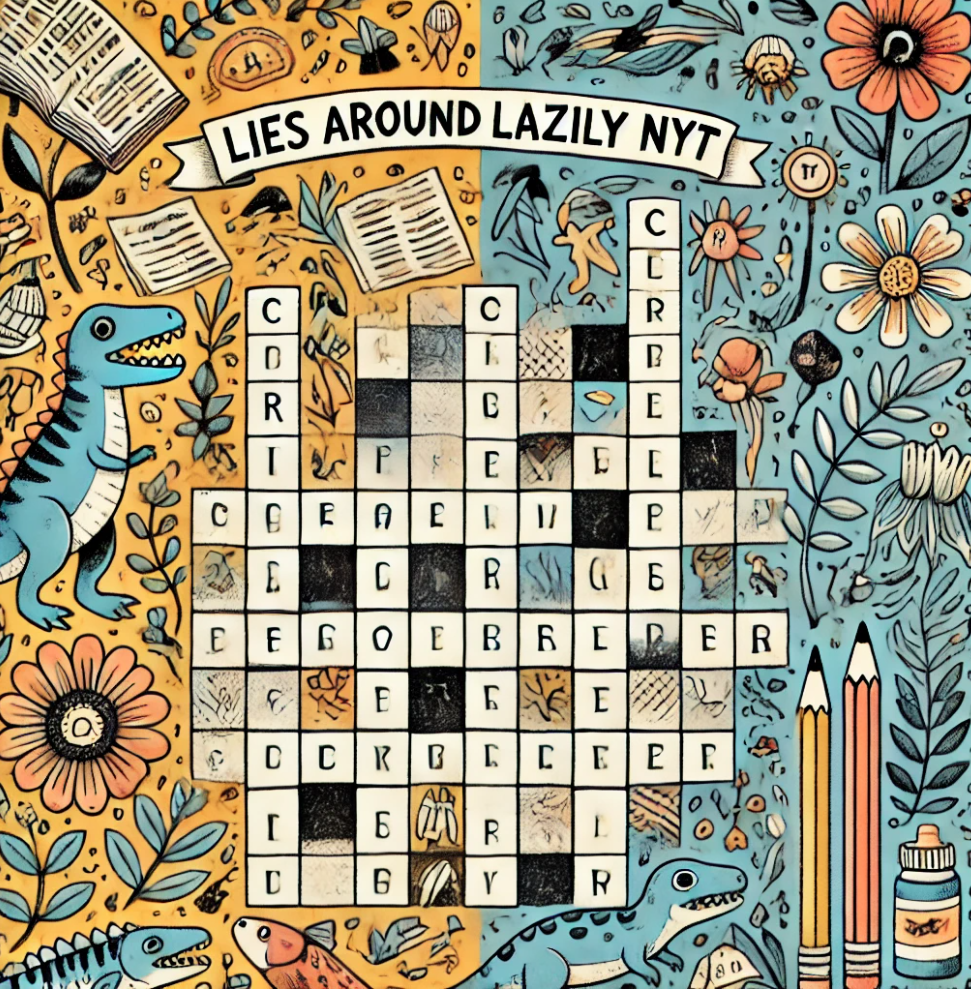Lies Around Lazily NYT: A Comprehensive Guide to Solving Crossword Clues
Crossword puzzles have long been a favorite pastime for many, offering a unique blend of challenge and satisfaction. One of the most popular sources for these puzzles is The New York Times, known for its clever and often tricky clues.
Among these, the clue “lies around lazily” has intrigued and sometimes stumped solvers. In this article, we will delve into the meaning, context, and possible solutions for the “lies around lazily NYT” clue. Additionally, we’ll explore the broader world of crossword puzzles, providing tips and insights that go beyond what’s already available online.
Introduction to “Lies Around Lazily NYT”
The Popularity of NYT Crossword Puzzles
The New York Times Crossword is one of the most beloved and respected puzzle games in the world. Known for its challenging clues and creative wordplay, the NYT crossword is a daily ritual for many, providing a mental workout that tests vocabulary, general knowledge, and lateral thinking. Among the many clues that solvers encounter, “lies around lazily” has become a point of intrigue.
Understanding the Clue: “Lies Around Lazily”
When confronted with a crossword clue like “lies around lazily,” the immediate task is to decipher what the clue is really asking. On the surface, it suggests inactivity or a state of lounging, but the exact answer could vary depending on wordplay, synonyms, or even double meanings. The clue’s simplicity is deceptive, as it can lead to multiple interpretations, each requiring careful consideration.
Why This Clue is Significant
“Lies around lazily” is significant because it embodies the subtle complexity that makes NYT crossword puzzles so engaging. It challenges solvers to think beyond the obvious and consider less direct meanings of words. Additionally, this clue is an excellent example of how language can be used creatively to offer a satisfying puzzle-solving experience.
Breaking Down the Clue
Analyzing the Language: What Does “Lies Around Lazily” Mean?
The phrase “lies around lazily” typically evokes an image of someone or something being idle or inactive. In a crossword context, it often refers to a synonym of such behavior or a word that describes a relaxed state. However, the beauty of crossword puzzles lies in the possibility of wordplay, where “lies” might have a different meaning, such as falsehoods or something lying down in a literal sense.
Common Crossword Strategies: Synonyms, Context, and Wordplay
To solve a clue like “lies around lazily,” solvers often rely on several strategies:
- Synonyms: Identifying words that mean the same or nearly the same thing as “lies around lazily.”
- Context: Considering the theme of the crossword or the surrounding answers to guide the solution.
- Wordplay: Recognizing if the clue plays on multiple meanings of “lies,” such as deception or physical position.
Possible Answers and Their Origins
One of the most common solutions for “lies around lazily” is the word “lounges.” This word fits the definition perfectly and matches the casual tone suggested by the clue. Another possible answer could be “loafs,” which similarly conveys a sense of laziness or inactivity. The choice between these answers often depends on the specific letters provided by intersecting words in the puzzle.
The Culture of NYT Crossword Puzzles
The History of The New York Times Crossword
The New York Times Crossword was first published in 1942, and since then, it has become a staple for puzzle enthusiasts. Over the decades, it has maintained a reputation for quality and difficulty, often being regarded as a benchmark for other crossword puzzles. The NYT puzzle is celebrated for its clever clues and the ingenuity of its constructors.
The Art of Crafting Crossword Clues
Crafting a crossword clue is an art form. Puzzle constructors spend hours, sometimes days, perfecting each clue to ensure it is challenging yet fair. Clues like “lies around lazily” demonstrate the constructor’s ability to use language in a way that is both engaging and thought-provoking. The goal is to create a satisfying “aha” moment when the solver finally figures out the answer.
How NYT Puzzles Differ from Other Crosswords
NYT crosswords are often more challenging than other puzzles because they demand a deep understanding of language, culture, and current events. The puzzles frequently include puns, wordplay, and references that require solvers to think creatively. This level of difficulty is what attracts a dedicated following and sets the NYT crossword apart from others.
Solving Techniques for Tricky Clues
Building a Vocabulary for Crosswords
To excel at solving crossword puzzles, particularly those from the NYT, building a robust vocabulary is essential. Regular practice with a variety of puzzles can help solvers familiarize themselves with common clues and answers. Additionally, learning obscure or less commonly used words can be beneficial, as NYT puzzles often include challenging vocabulary.
The Role of Themes in NYT Puzzles
Many NYT crossword puzzles feature a theme, which can provide valuable hints for solving tricky clues. Understanding the theme can narrow down possible answers and reveal connections between different parts of the puzzle. For example, if the theme revolves around relaxation or leisure, “lies around lazily” might align perfectly with that concept.
Recognizing Common Patterns and Tricks
Experienced solvers often recognize patterns and tricks used by crossword constructors. For example, clues that involve wordplay, anagrams, or homophones are common in NYT puzzles. Identifying these patterns can make solving even the most challenging clues, like “lies around lazily,” more manageable.
The Broader Appeal of Crossword Puzzles
Why People Love Crosswords: Cognitive and Emotional Benefits
Crossword puzzles offer numerous cognitive and emotional benefits. They stimulate the brain, improve vocabulary, and enhance problem-solving skills. Additionally, the sense of accomplishment from completing a challenging puzzle can boost mood and provide a sense of satisfaction. For many, the daily ritual of solving the NYT crossword is a way to unwind and engage in a mentally stimulating activity.
The Social Aspect: Crossword Communities and Competitions
Crosswords are not just a solitary activity; they have a vibrant social aspect as well. Online forums, social media groups, and puzzle clubs bring together enthusiasts who share tips, discuss tricky clues, and celebrate their love for the game. Competitions like the American Crossword Puzzle Tournament (ACPT) offer solvers a chance to showcase their skills and connect with others who share their passion.
Crossword Puzzles in Popular Culture
Crossword puzzles have made their mark in popular culture, appearing in films, TV shows, and literature. The NYT crossword, in particular, is often referenced as a symbol of intellectual challenge and wit. Characters in movies and books are frequently depicted as crossword solvers, reflecting the puzzle’s status as a cultural icon.
The Evolution of Crossword Puzzles in the Digital Age
Online Crosswords and Apps
The rise of digital technology has transformed the way people solve crosswords. Online platforms and mobile apps have made puzzles more accessible than ever before. Websites like The New York Times’ own crossword section allow solvers to tackle puzzles on their computers or mobile devices, offering features like hints, timers, and daily challenges.
How Technology Has Changed Crossword Solving
Technology has not only made crosswords more accessible but has also changed the way they are solved. Tools like online dictionaries, anagram solvers, and crossword-specific apps can help solvers overcome difficult clues. However, purists may argue that these tools detract from the puzzle-solving experience, which traditionally relies on one’s own knowledge and reasoning skills.
The Future of Crossword Puzzles
As crossword puzzles continue to evolve, their future looks bright. The integration of AI in puzzle creation and solving, the expansion of interactive and themed puzzles, and the growing global community of solvers all point to a thriving future for crosswords. The timeless appeal of these puzzles ensures that they will remain a beloved pastime for generations to come.
FAQ Section
What Does “Lies Around Lazily” Mean in Crossword Puzzles?
In crossword puzzles, “lies around lazily” generally refers to a state of idleness or inactivity. Possible answers might include words like “lounges” or “loafs,” depending on the puzzle’s specific context and wordplay.
How Do I Approach Difficult Clues Like This One?
Approaching difficult clues involves analyzing the language, considering synonyms, and looking for wordplay. Additionally, examining the puzzle’s theme and using the letters from intersecting answers can provide valuable hints.
Are There Any Tools or Apps That Can Help with NYT Crossword Puzzles?
Yes, there are several tools and apps available that can assist with NYT crossword puzzles. Online dictionaries, anagram solvers, and crossword-specific apps like “Crossword Solver” can help solvers find answers and improve their skills.
What Are Some Tips for Improving My Crossword Skills?
To improve your crossword skills, practice regularly with a variety of puzzles, build your vocabulary, and familiarize yourself with common crossword tricks and themes. Engaging with crossword communities and studying completed puzzles can also enhance your solving abilities.
Why Are NYT Crosswords Considered More Challenging?
NYT crosswords are considered more challenging because they often include clever wordplay, obscure references, and complex themes. The puzzles require a deep understanding of language, culture, and lateral thinking, making them a rewarding challenge for solvers.
Conclusion
Final Thoughts on “Lies Around Lazily NYT”
The clue “lies around lazily NYT” exemplifies the creativity and challenge that make The New York Times crossword puzzles so beloved. Whether you are a seasoned solver or new to the world of crosswords, tackling clues like this one offers an opportunity to sharpen your mind and enjoy the satisfaction of finding the right answer.
Encouragement to Keep Solving and Improving
Crossword puzzles are a journey of continuous learning and improvement. Each puzzle you solve, especially challenging ones like those from the NYT, helps build your skills and deepen your appreciation for the art of crossword construction. Keep solving, stay curious, and enjoy the process of uncovering each puzzle’s hidden secrets.
The Timeless Appeal of Crossword Puzzles
Crossword puzzles have stood the test of time, captivating solvers for over a century. Their blend of language, logic, and creativity ensures that they remain a timeless and cherished activity. As technology advances and puzzles evolve, the fundamental appeal of crosswords—solving the seemingly unsolvable—continues to draw people in, making them a beloved part of daily life.






